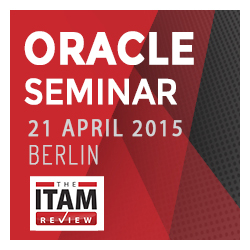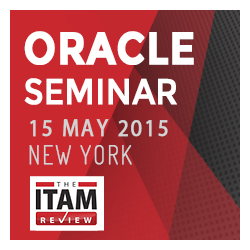Oracle License Management
 Oracle licensing is one of the most complex license metrics to manage within the IT Asset Management community. It poses the biggest challenge for ITAM, SAM (software asset management) and licensing professionals alike. There are only a few vendors that require specialist experts to effectively manage the licenses and software correctly, and Oracle is certainly one of them.
Oracle licensing is one of the most complex license metrics to manage within the IT Asset Management community. It poses the biggest challenge for ITAM, SAM (software asset management) and licensing professionals alike. There are only a few vendors that require specialist experts to effectively manage the licenses and software correctly, and Oracle is certainly one of them.
Oracle Licensing
The number of products and acquisitions made by Oracle over the years has resulted in numerous price lists and a wide array of licensing possibilities and extended definitions. Keeping track of the changes that effect your organisation might seem like an impossible undertaking. Oracle also rarely communicates changes with their end users properly, so customers end up performing actions outside of their license agreement. This in turn can result in a huge fine should Oracle ever audit the organisation.
For Oracle, as for many ICT companies, the technological possibilities today, determine the licensing of tomorrow. At first glance (or review), the perception is that Oracle licensing strategy is steered by commercial gains. However, when you closely observe the changes made over the last decade, there is logic behind the changes and an on-going effort to make licensing transparent and accessible.
It is worth noting that with Oracle licensing, the licensing associated with each product is related to their position in this infrastructure and how they are deployed. This has led to over 80 license metrics in today’s list of license metrics, but a lot of these are for very specific products or groups of products.
The Risks of Oracle License Mismanagement
Mismanaging software licenses in general is a bad thing for any organisation, but mismanaging Oracle licenses is a completely different beast. A small error in judgement, or the use of a certain feature within an Oracle database can lead to huge fines for an organisation.
For example, Oracle has recently introduced a database patch that includes a feature called ‘in-memory’ technology. This ‘in-memory’ technology could cost $23,000 per CPU. The risk here is that the new feature will be available to anyone who updates, regardless of whether they have the correct license or not. This means someone on the database team could update their software, see the new feature and start using it. They could then tell others within the team, and before you know it ten people are using the new ‘in-memory’ feature. That’s $230,000 worth of non-compliancy.
Oracle licensing and the management of said licenses is a massive challenge. Oracle has spent many efforts in simplifying their licensing. They publish their licensing and rules on their website and the online purchasing systems like the Oracle Store. However due to their acquisitions, the number of product and flexibility in usage, it has become complex for the end-user to understand.
On top of that Oracle offers lifetime support (including updates) on almost all products. This has resulted in a wide number of licensing definitions, rules and interpretations, all still valid today, if they are in your agreement. Thankfully, there are now a number of tools on the market to help organisations manage their Oracle estate.
Oracle Tool Considerations
There are a number of considerations that should be thought about when selecting the right a tool to manage Oracle Licensing. Organisations need to ask the following questions to any Oracle tool vendor to ensure they find the right solution for their environment, and to ensure that the tool will enable them to manage their Oracle licenses effectively:
- Do you sell or profit from Oracle Licensing?
- Is your company an Oracle partner, verified or in any way affiliated with Oracle?
- Besides the product/service being reviewed – what services do you offer that support clients with the management of their Oracle estate? (E.g. Audit defence, license reconciliation, consulting etc.)
- Please provide a high level overview of any features or deliverables that aid Oracle license management
- What specific product lines/product families does your product/service work with? E.g. is it just Oracle databases or do you also work with other products or product families? PeopleSoft/Siebel/BEA/JDE and other business apps. Please specify the limitations or scope of Oracle coverage.
- How are instances and installs of Oracle identified? How is data verified and false positives identified?
- How are the configurations of Oracle products and accessible options identified and managed?
- Please describe any features relevant to managing Oracle in virtual environments
- How does your technology/service interact or support the Oracle LMS auditing and review process (e.g. Provision of data, population of Oracle Server Worksheets, working with LMS, Oracle verified status etc.)
- Please provide a high level summary of any features or deliverables that aid clients with Oracle negotiations and reducing Oracle spend
We haven’t just listed the questions above to make the processes of picking an Oracle License Management solution longer, or more complex, they are extremely important aspects to consider when thinking about the management of Oracle licenses, for finding a solution that is fit-for-purposes within an organisation.
It is also important to see if the tool is Oracle verified. Oracle tool verification is provided by Oracle LMS, the same team that coordinates Oracle audits. Oracle LMS also offer help to assist companies with their broader ITAM strategy. Not all tools are verified, but this doesn’t mean that can help the organisation manage their Oracle licenses any less.
Managing Oracle Databases
Hand-in-hand with the management of Oracle licenses, Oracle databases also need to be effectively managed to ensure that licenses are optimised. There are a number of technical factors to consider when managing Oracle databases;
| DISCOVERY | Does your technology auto-discover the existence of Oracle databases? |
| AGENT or AGENTLESS | Which scanning option is better for your IT infrastructure |
| HARDWARE | Track the underlying hardware of Oracle database instances (Hardware specification, processors, cores) |
| VIRTUAL | Calculate whether an Oracle database instance is installed within a virtual machine and track the virtual to physical relationship |
| CLUSTER | Identify whether an Oracle database instance is connected or otherwise related to other virtual instances |
| SOFTWARE | Track the version of Oracle database |
| USERS | Track the user list of the Oracle database |
| OPTIONS & PACKS | Track whether Oracle database options are a) Installed and b) In use c) When they were switched on |
| ROOT CAUSE | Identify why Oracle database packs and options were switched on |
| OSW | Auto-populate Oracle Server Worksheet |
| REPORTING | Assist in calculating compliance or generating relevant reports to support compliance and optimisation |
| ARCHITECTURE OPTIMISATION | Forecast alternate configurations – meet the same technical goals using simpler or cheaper methods. |
We at the ITAM Review found point 12 particularly interesting and represents where the SAM market is going. It represents the next maturity step beyond compliance. “Now that we have proven compliance – let us optimise our architecture so we’re delivering the same or better technical solution with a more efficient or suitable licensing structure”. Partners have a key role to play here in helping customers structure their architecture in a way that gets the job done whilst tiptoeing through contractual terms.
ITAM Review Group Test
We recently provided an independent review and comparison of specialist tools for managing Oracle licensing. Oracle has hundreds of different components to their solution, and ITAM Review readers told us that the proliferation of Oracle databases and their configuration was a key concern. It should also be noted that Oracle tool verification only pertains to Oracle Enterprise Edition databases.
The Results
SAM is first and foremost a governance process – identifying and managing risk. Given the impact and financial risk associated with Oracle in large enterprises – we felt that Lime Software went the extra mile in terms of the verification of data, had good coverage of Oracle License Management features and is competitively priced. Just because Oracle is eye wateringly expensive doesn’t mean the tools to manage it have to be equally expensive and complicated.
We have awarded Lime Software Best in Class in this review for Oracle License Management because:
- Lime offers a good array of competitive features for managing Oracle compared to other technology in this review
- Lime has additional features focussed at the verification of data to support Oracle License Management
- Is very competitively priced
This isn’t to say that you’d agree with our findings as different solutions work well in different environments and for customers with different needs.
If you would like further information on managing the complexity of your Oracle licensing agreement why not join us at one of our free events taking place this year? For more details visit our Events Page
Related articles:
- Tags: licensing · Lime Software · Oracle · oraclefeature · Risk · software · Software Asset Management · software licenses · tool consideration



Some great point on managing Oracle licensing.
On tool(s) selection I’d also ask the questions:
1. Does it support scanning of the major operating systems and visualization technologies your organization deploy Oracle products on
2. How good is the tool on measuring Middleware in addition to database
3. What level of support is there for finding and measuring other Oracle products.
4. How easy is it to administer the tool and run weekly & monthly scans of network.
Your point on Architecture optimization is also interesting and not something I see many tools supporting today, but that will no doubt change